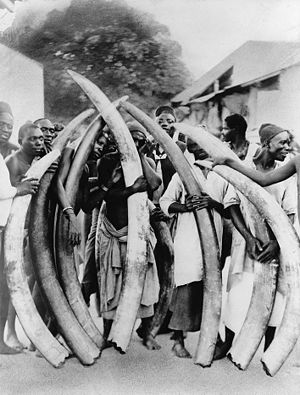 |
| Taken in the Ngorongoro crater, Tanzania (Photo credit: Wikipedia) |
"The word 'ivory' rang in the air, was whispered, was sighed. You would think they were praying to it" - Joseph Conrad in Heart of Darkness.
The slaughter of elephants and the seizure of illegal ivory have soared to their highest levels in decades. A voracious market in Asia and chaotic wildlife protection in much of Africa have put elephant herds at risk throughout the African continent, particularly in Central and East Africa. Poachers are gunning down whole families, oblivious to game scouts.
A key battleground is Tanzania, one of the world's last great repositories of elephants. Perhaps 70,000 to 80,000 elephants roam this nation's immense sanctuaries, amounting to perhaps a quarter of all African elephants.
In colonial times, the Tanzanian island of Zanzibar held the largest ivory auctions in the world. Today Tanzania has regained that infamy. Those public auctions have been replaced by underground networks of smugglers, but Tanzania remains a leading source of ivory.
From 2009 to 2011, the country was the leading exporter of illegal ivory in the world. Thirty-seven percent of all elephant tusks seized by law enforcement came from Tanzania, with neighboring Kenya a close second.
On Saturday, customs officials in Hong Kong announced the seizure of nearly 4 tons' worth of ivory hidden in two containers shipped from Indian Ocean ports in Tanzania and Kenya. Whether the ivory is merely transshipped through Tanzanian ports or plundered from its parks is a point of contention.
Few Protections For Elephants
Conservationists say Tanzania has for years been one of Africa's worst elephant slaughterhouses. They blame authorities who are unable or unwilling to control poaching and trafficking. The government acknowledges there is a problem and says reforms are under way.
"There's an enormous slaughter of elephants going on in Tanzania right now. Things are out of hand," says Iain Douglas-Hamilton, who has been studying and protecting elephants in Africa for 47 years. "There's no protection in numbers for elephants any more than there was for bison in the last century when they were all wiped out in America. So people shouldn't kid themselves."
Wildlife rangers in Tanzania came across this elephant that had been killed for its ivory. Tanzania says it wants to prevent the slaughter of elephants, but rangers are poorly paid and are responsible for monitoring vast game reserves in the East African country. Tanzania had been curiously mute over the massacre of its elephants. But recently, an avuncular, white-haired member of Parliament offered this grim assessment.
"Thirty elephants per day. At the end of the year, you're talking about 10,000 elephants killed," says James Lembeli, chairman of Parliament's Natural Resources Committee and a former National Parks official. "Move around this country where you have populations of elephants: carcasses everywhere."
In Search Of Dead Elephants
I decided to go see for myself. Two Masai tribesmen in tire-tread sandals use elaborate whistling to herd their cattle. They know this landscape of dry thorn brush and tawny grass intimately. So they lead us to a recent elephant kill on the Tanzania-Kenya border.
We walked up on the carcass of a dead elephant. It was killed sometime last month. All that's left is a great leathery hide, gray on the outside, pink on the inside, decomposing on the savanna. The poachers hauled off the tusks. The villagers came and cut away all the meat, and took the head and bones. The scene is being repeated again and again across Tanzania.
The poachers come in all types in Africa these days. The Democratic Republic of Congo recently accused Ugandan soldiers of machine-gunning elephants from a military helicopter. Some poachers track jumbo elephants on foot for days like big-game hunters. Others use high-tech shortcuts.
Robert Waltenburg manages Lake Chala Safari Camp, a small, private game reserve where we found the carcass. It's one of eight elephants killed here in recent weeks.
To read further, go to: http://www.npr.org/2012/10/25/163563426/poachers-decimate-tanzanias-elephant-herds





